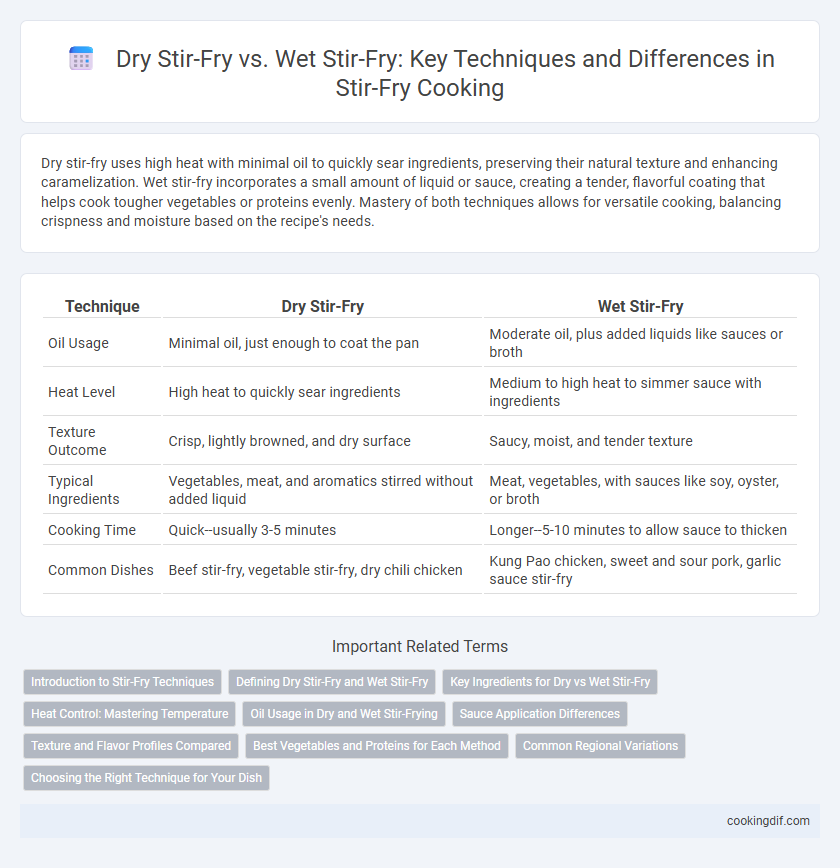Dry stir-fry uses high heat with minimal oil to quickly sear ingredients, preserving their natural texture and enhancing caramelization. Wet stir-fry incorporates a small amount of liquid or sauce, creating a tender, flavorful coating that helps cook tougher vegetables or proteins evenly. Mastery of both techniques allows for versatile cooking, balancing crispness and moisture based on the recipe's needs.
Table of Comparison
| Technique | Dry Stir-Fry | Wet Stir-Fry |
|---|---|---|
| Oil Usage | Minimal oil, just enough to coat the pan | Moderate oil, plus added liquids like sauces or broth |
| Heat Level | High heat to quickly sear ingredients | Medium to high heat to simmer sauce with ingredients |
| Texture Outcome | Crisp, lightly browned, and dry surface | Saucy, moist, and tender texture |
| Typical Ingredients | Vegetables, meat, and aromatics stirred without added liquid | Meat, vegetables, with sauces like soy, oyster, or broth |
| Cooking Time | Quick--usually 3-5 minutes | Longer--5-10 minutes to allow sauce to thicken |
| Common Dishes | Beef stir-fry, vegetable stir-fry, dry chili chicken | Kung Pao chicken, sweet and sour pork, garlic sauce stir-fry |
Introduction to Stir-Fry Techniques
Dry stir-fry involves cooking ingredients quickly over high heat with minimal oil, allowing vegetables and proteins to retain a crisp texture and concentrated flavors. Wet stir-fry adds sauces or broths during cooking, creating a flavorful, slightly saucier dish that helps tenderize tougher ingredients. Mastery of both techniques enhances versatility, enabling cooks to tailor texture and flavor profiles to suit various Chinese cuisine styles.
Defining Dry Stir-Fry and Wet Stir-Fry
Dry stir-fry involves cooking ingredients quickly over high heat with minimal oil and no added liquid, resulting in crisp textures and concentrated flavors. Wet stir-fry includes adding sauces or broths during cooking, creating a saucier, more tender dish with enhanced moisture. Understanding these techniques allows chefs to tailor texture and flavor profiles in Asian cuisine effectively.
Key Ingredients for Dry vs Wet Stir-Fry
Dry stir-fry involves cooking ingredients quickly over high heat with minimal oil, emphasizing crisp vegetables and thinly sliced proteins like beef, chicken, or tofu to preserve texture and enhance natural flavors. Wet stir-fry incorporates a flavorful sauce, often based on soy sauce, oyster sauce, or broth, which helps tenderize ingredients such as meat and adds moisture to vegetables like bok choy or mushrooms. Key ingredients in dry stir-fry include garlic, ginger, and chili for seasoning, while wet stir-fry relies on cornstarch slurry to thicken sauces and balance savory, sweet, and umami elements.
Heat Control: Mastering Temperature
Dry stir-fry relies on high heat with minimal oil to quickly sear ingredients, emphasizing precise temperature control to prevent burning and achieve a crispy texture. Wet stir-fry incorporates sauces or broths, requiring moderate heat to balance simmering and frying, ensuring flavors meld without overcooking. Mastering temperature adjustments in both techniques enhances ingredient texture, flavor retention, and overall dish quality.
Oil Usage in Dry and Wet Stir-Frying
Dry stir-fry uses minimal oil, allowing ingredients like vegetables and lean meats to cook quickly over high heat without excessive moisture, preserving their natural texture and flavor. Wet stir-fry incorporates more oil to create a sauce or broth, enhancing ingredient tenderness and integrating flavors while maintaining a balanced oily coating. Proper oil usage in both techniques is essential for achieving the desired texture and flavor profile in stir-fry dishes.
Sauce Application Differences
Dry stir-fry uses minimal or no sauce during cooking, allowing ingredients to sear quickly over high heat and maintain a crisp texture, with sauce typically added at the end for flavor. Wet stir-fry incorporates more liquid components or sauce from the beginning, creating a simmering effect that softens ingredients and produces a rich, coated dish. The key difference in technique lies in sauce application timing and quantity, impacting texture and flavor absorption.
Texture and Flavor Profiles Compared
Dry stir-fry employs high heat with minimal or no liquid, resulting in a crisp, caramelized texture that enhances the natural flavors through Maillard reaction. Wet stir-fry incorporates sauces or broths, producing a tender texture with a rich, savory taste that balances spices and aromatics. Choosing between dry and wet stir-fry techniques depends on the desired texture contrast and depth of flavor integration in the final dish.
Best Vegetables and Proteins for Each Method
Dry stir-fry techniques excel with firm vegetables such as broccoli, bell peppers, and snap peas, alongside proteins like beef, chicken, and tofu, which benefit from high heat and minimal liquid to achieve a crisp texture. Wet stir-fry methods suit softer vegetables such as bok choy, mushrooms, and zucchini, complemented by proteins like shrimp and fish, where added sauces or broths enhance tenderness and flavor. Selecting the appropriate technique preserves texture and maximizes nutrient retention for each vegetable and protein.
Common Regional Variations
Dry stir-fry techniques, prevalent in Sichuan cuisine, emphasize high heat and rapid cooking with minimal sauce to preserve the texture and aroma of ingredients, especially chili peppers and Sichuan peppercorns. Wet stir-fry, common in Cantonese cooking, incorporates moderate amounts of flavorful sauces like oyster or soy sauce, creating a moist, glossy finish that enhances tenderness and depth of flavor. These regional variations highlight the balance between preserving ingredient integrity and infusing savory sauces, reflecting distinct cultural preferences in Chinese culinary arts.
Choosing the Right Technique for Your Dish
Dry stir-fry uses high heat with minimal oil, creating a quick sear that locks in flavor and preserves texture, ideal for crisp vegetables and small, uniform pieces of meat. Wet stir-fry incorporates a sauce or broth, allowing ingredients to cook in a flavorful liquid that adds moisture and depth, perfect for tender cuts and dishes requiring a saucy finish. Selecting between dry and wet stir-fry depends on the desired texture and flavor profile, with dry stir-fry emphasizing caramelization and wet stir-fry enhancing sauciness.
Dry stir-fry vs Wet stir-fry for technique Infographic

 cookingdif.com
cookingdif.com